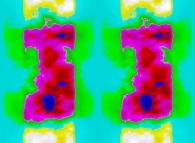
A 'crumpled' sphere defined by means of three bidimensional fields [Une sphère 'froissée' définie à l'aide de trois champs bidimensionnels].

A 'crumpled' sphere defined by means of three bidimensional fields [Une sphère 'froissée' définie à l'aide de trois champs bidimensionnels].
X = Fx(u,v)
Y = Fy(u,v)
Z = Fz(u,v)with:
u ∈ [Umin,Umax]
v ∈ [Vmin,Vmax][Umin,Umax]*[Vmin,Vmax] then defined a bidimensional rectangular domain D.
v ^
|
V |...... ---------------------------
max | |+++++++++++++++++++++++++++|
| |+++++++++++++++++++++++++++|
| |+++++++++++++++++++++++++++|
| |+++++++++++++++++++++++++++|
| |+++++++++++++++++++++++++++|
| |+++++++++++++++++++++++++++|
| |+++++++++++++++++++++++++++|
| |+++++++++++++++++++++++++++|
| |+++++++++++++++++++++++++++|
V |...... ---------------------------
min | : :
| : :
O------------------------------------------------->
U U u
min max
X = Mx(i,j)
Y = My(i,j)
Z = Mz(i,j)with:
i = f(u,Umin,Umax,Nu)
j = g(v,Vmin,Vmax,Nv)where 'f' and 'g' denote two obvious linear functions...
 ) differs from the one used for the 'X' and 'Y' coordinates
(
) differs from the one used for the 'X' and 'Y' coordinates
( ) in order to avoid discontinuities at the two poles.
) in order to avoid discontinuities at the two poles.
u ∈ [0,pi]when:
v ∈ [0,2.pi]
 See the perfect sphere.
See the perfect sphere.
 See an helix on this 'crumpled' sphere.
See an helix on this 'crumpled' sphere.
 See its normal field.
See its normal field.